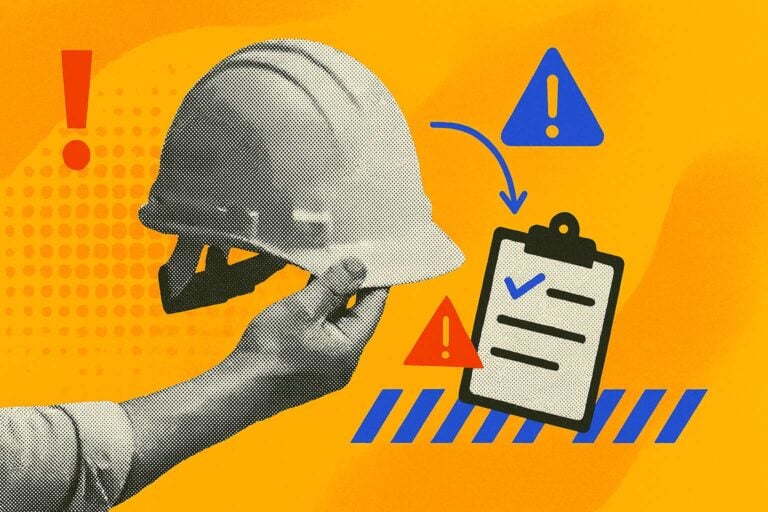Construction sites are full of health and safety risks that could injure workers, stall projects, and expose you to costly penalties.
Luckily, most accidents are preventable with smart health and safety planning. While the Occupational Safety and Health Administration (OSHA) sets clear standards, many contractors feel overwhelmed by the technicalities and struggle to put them into practice.
Below, I walk you through the most common construction safety hazards. I also break down key OSHA regulations and share practical tips to help you anticipate your safety needs, train your crew, and ensure your worksites are truly secure.
Key Takeaways
- Construction site hazards like falls, electrical accidents, caught-in/between, and struck-by incidents remain the leading causes of injuries and fatalities.
- But extreme weather, exposure to chemicals, and ergonomic strain are also dangerous and deadly risks.
- Prevention is possible with proper training, equipment, site-specific safety plans, and a safety-first culture.
- Meeting legal OSHA requirements protects workers and shields companies from costly fines and legal action.
Primary Health and Safety Hazards in Construction: The Fatal Four
A report published by the Center for Construction Research and Training showed that 65% of fatal construction injuries occur as a result of the “Fatal Four” hazards.
Here’s what these are and how to prevent them.
Falls
Falls are the leading cause of construction fatalities, contributing to more than 1 in 3 preventable deaths.
Common causes
- Unprotected edges: Workers can fall from roofs, mezzanines, or open floors if barriers, guardrails, floor hole covers, or personal fall arrest systems (like harnesses and lanyards) aren’t in place.
- Unsafe ladders: Ladders set at the wrong angle, not secured properly, or extended too little above the landing point put workers at risk.
- Faulty scaffolding: Missing planks, incorrect assembly, and weak bracing can lead to scaffolds giving way under workers’ weight.
- Slippery or messy surfaces: Water, construction debris and hazards (like oil, grease, or chemicals), and scattered construction tools can result in slips and trips.
Prevention tips
- Install guardrails, barriers, and safety nets, or require personal fall arrest systems when working at a height.
- Cover floor openings or restrict access to them with sturdy barriers.
- Inspect and properly secure all ladders and scaffolding before use.
- Keep walkways, work areas, and other surfaces clear of water, ice, and other debris, or mark them with safety cones or visible warning signs if you can’t do this right away.
Key OSHA regulations
OSHA requires fall protection for anyone working 6+ feet above the nearest level underneath them. This includes fall systems like guardrails, safety nets, and personal fall arrest harnesses.
There are also strict standards in place for scaffolds and ladders. For instance, scaffolds must support at least 4 times their intended load and include guardrails, while ladders should be secured properly, be slip-resistant, and extend at least 3 feet above the landing surface.
Caught-in/between
These types of incidents happen when a worker is trapped, crushed, or compressed between 2 or more objects or parts of an object, including equipment, heavy machinery, or collapsing structures.
Common causes
- Falling loads: Workers can get trapped under heavy materials if they fall due to manual or technical issues with the cranes or forklifts carrying them.
- Excavation collapses: Improper shoring and sloping and soil instability can lead to trench cave-ins that bury workers.
- Unguarded heavy machinery: Moving parts of rollers, conveyors, mixers, and other equipment can suck or pull workers in if proper guards and barriers aren’t in place.
- Caught between vehicles or fixed objects: Workers can get pinned when vehicles back into structures like walls, columns, fences, parked equipment, and more due to oversights or tight maneuvers.
Prevention tips
- Train your crew to never stand under suspended loads and always secure rigging before lifting materials.
- Use protective systems like sloping, shoring, and shielding in trenches and excavations.
- Install barriers and other safety guards to prevent workers from coming into contact with heavy machinery.
- Establish clear traffic routes for vehicles, and use spotters to prevent workers from getting pinned.
Key OSHA regulations
OSHA requires protective systems for trenches 5 feet or deeper, unless they’re made entirely in stable rock.
Additionally, employers must ensure all machinery is properly guarded, equipment and materials are kept at least 2 feet away from the edges of excavations, and workers in trenches have safe access and egress (exit equipment like ladders, stairs, or ramps). These should be placed so that no one has to travel more than 25 feet laterally to get out.
Struck-by
These injuries happen from the force of impact, typically when a worker is hit by a moving object like a tool, vehicle, or piece of equipment. Research shows that about 75% of struck-by fatalities involve heavy equipment such as trucks or cranes.
Common causes
- Vehicles and equipment: When those operating forklifts, dump trucks, backhoes, and other equipment in congested areas can’t see workers, accidents can happen.
- Falling loads: Workers can also get struck by suspended loads falling from cranes and hoists if the rigging fails or load shifts unexpectedly.
- Other falling objects: Construction tools, materials, or debris dropped from a height—for example, from cranes or scaffolding—can gravely injure team members below.
- Flying particles: Power tools like saws, grinders, and nail guns can send shrapnel and other particles flying that hurt workers if protective guards are missing or personal protective equipment (PPE) isn’t used.
Prevention tips
- Designate traffic routes for vehicles and assign spotters (workers who guide drivers and watch blind spots) to prevent accidents.
- Use proper rigging techniques and secure loads, and allow only trained workers to operate cranes and hoists.
- Ensure workers wear hard hats and keep areas below clear when lifting or stacking materials.
- Install protective guards on power tools and make safety glasses, hard hats, or the entire PPE kit mandatory (depending on the equipment being used).
- Regularly inspect tools and materials that are prone to falling, breaking, or being knocked loose.
Key OSHA regulations
You must require hard hats and take one of the following steps: “erect toeboards, screens, or guardrail systems to prevent objects from falling; erect a canopy structure as a protective overhead covering; or barricade the area below so objects can’t fall into it.”
You must also restrict crane operations and rigging to certified workers, keep swing areas clear, and ensure heavy equipment and vehicles have backup alarms and safe traffic controls in place.
Did You Know?
Connecteam’s team documents feature is a clever way to store and track your workers’ licenses and certifications. You can even set expiration dates and auto-reminders when it’s time to renew.
Electrocution and other electrical hazards
Electricity is one of the most dangerous hazards on construction sites, often resulting in shocks, burns, and even fatalities.
Common causes
- Overhead or buried power lines: Workers using ladders, cranes, or scaffolds can accidentally come into contact with live lines overhead, while excavation workers can strike underground utilities.
- Faulty or damaged electrical tools and cords: Poorly maintained equipment, frayed extension cords, or exposed wiring can shock workers directly, energize any conductive surfaces, or ignite nearby flammable materials.
- Improper grounding or overloaded circuits: Tools or temporary wiring without proper grounding and circuits loaded with too many devices increase the risk of shocks.
- Lack of LOTO (lockout/tagout): Machines or circuits that aren’t powered off during maintenance and repairs can unexpectedly start up and electrocute the worker.
Prevention tips
- Identify and mark overhead or buried power lines clearly.
- Use ground-fault circuit interrupters (GFCIs) and ensure all tools are properly grounded or double-insulated before use.
- Distribute electrical demand across multiple circuits and use breakers to avoid overloads.
- De-energize (cut the power source) and lockout (apply a lock) or tagout (add a clear warning mark) power lines and machines before any work or repair work begins.
- Inspect all electrical tools and cords regularly, and immediately replace damaged equipment.
Key OSHA regulations
You must de-energize and lock out live parts before work begins, and circuits that can’t be shut down should be guarded to prevent accidental contact.
Employers must install GFCIs on all 120-volt outlets used for temporary power, keep extension cords intact, and protect flexible wiring from sharp edges, traffic, or water. You must also encourage employees to maintain at least 10 feet from overhead or buried power lines with up to 50kV.
Pro Tip
The best contractor apps let you assign tasks, subtasks, and customizable checklists right into workers’ shifts—so you could, for instance, create a detailed lockout and tagout checklist for maintenance shifts (and set them to repeat).
Overlooked but Dangerous Health and Safety Hazards in Construction
A study of over 280 construction workers found that workers recognized 57% of the fatal four hazards but only 18% of other risks. These additional hazards can be just as deadly.
Here’s what they are.
Environmental or weather-related hazards
Extreme weather conditions pose serious risks on construction sites. This could look like heatstroke, hypothermia, falls and slips, and even equipment malfunctions, depending on conditions.
Common causes
- Prolonged and severe heat: Long hours in high temperatures can lead to heat exhaustion, dehydration, and even heat stroke.
- Extreme cold: Freezing conditions, especially without proper protection, can lead to hypothermia or frostbite.
- Rain, ice, or snow: These can make surfaces slippery and increase the risk of injury.
- Sudden storms or high winds: These forms of severe weather can make roofs, scaffolds, and ladders unsafe.
- Poor air quality: Wildfires, dust, smoke, and other pollutants can cause long-term damage to workers’ lungs.
Prevention tips
- Monitor weather forecasts and adjust schedules when necessary.
- Provide shade, water, and frequent rest breaks in hot weather.
- Supply appropriate clothing for cold temperatures and masks when workers are exposed to poor air quality.
- Secure tools, materials, and equipment during storms and maintain safe walking surfaces.
Key OSHA regulations
You must provide access to potable water and encourage acclimatization programs (where you gradually increase exposure) for heat. For cold, provide protective clothing and train workers on hypothermia and frostbite risks. Work must also be suspended in lightning or severe storm conditions.
Did You Know?
Connecteam’s employee updates tool lets you push urgent company-wide communications, such as storm warnings, to your entire team and require confirmation that they’ve read it.
Ergonomic risks and musculoskeletal injuries
Construction work often involves repetitive movements, awkward postures, and heavy lifting, increasing the likelihood of developing musculoskeletal disorders and long-term disabilities.
Common causes
- Manual handling of equipment and materials: Lifting, pushing, or carrying heavy objects without proper support or assistive equipment.
- Repetitive motions: Movements like bending, twisting, and reaching, or even continually drilling, hammering, and using tools, can strain muscles and joints.
- Vibration exposure: Prolonged use of jackhammers, drills, and other vibrating tools can cause hand-arm vibration syndrome, with symptoms like tingling, weakened grip strength, and other long-term issues.
Prevention tips
- Provide workers with lifting aids, such as hoists and forklifts, for handling heavy materials.
- Train workers on safe lifting techniques, proper posture, and ergonomic practices to reduce strain.
- Rotate tasks and encourage regular breaks to reduce repetitive strain.
Key OSHA regulations
OSHA doesn’t have legally binding standards around ergonomics, but it provides guidance, including setting up worksite assessments, modifying existing equipment, and training workers on the proper use of workplace tools.
Chemical hazards
Prolonged or accidental exposure to harmful chemicals found on construction sites can lead to skin irritation, respiratory problems, poisoning, or long-term illnesses like cancer.
Common causes
- Dust exposure: Workers might inhale silica and other debris when they cut, grind, or drill into concrete, stone, or drywall.
- Asbestos: Working on old flooring, roofing, or insulation can release asbestos fibers into the air, which have been linked to lung disease and cancer.
- Welding vapors: Metalwork generates toxic fumes, which, over time, can cause respiratory and eye irritation, fever, chronic lung disease, neurological damage, and even cancer.
- Solvents and adhesives: These chemicals, found in paints, coatings, and industrial cleaners, can irritate the skin and harm the nervous system.
Prevention tips
- Require proper PPE, including respirators, gloves, and eye protection.
- Ensure chemicals are labeled, stored, handled, and disposed of correctly.
- Use wet methods to control dust or provide adequate ventilation through exhaust systems in confined spaces.
- Replace toxic products with safer alternatives when possible.
Key OSHA regulations
OSHA sets permissible exposure limits for different types of hazardous substances and requires that you monitor air quality on job sites and provide your crew with PPE. Additionally, it requires proper labeling of chemicals, access to Safety Data Sheets (SDS), dust control, and medical monitoring. Employers must adhere to specific asbestos regulations when working with materials that may contain it.
Pro Tip
Store your SDSs and other training materials in Connecteam’s company knowledge base, so they’re available at workers’ fingertips anytime they need access.
Construction Safety Best Practices
Here’s how to implement an effective health and safety plan in your construction company.
Encourage a safety-first culture
Brian Hval, a safety manager, rightfully said, “The best practices for construction safety are useless without a serious commitment to safety.”
Whether you’re just starting your construction business or growing and scaling it, you must prioritize building a culture that truly empowers workers to speak up about hazards, follow procedures consistently, and look out for one another on-site.
How to build a safety-first culture
- Lead by example by modeling safe behavior.
- Create open communication channels for workers to report hazards without fear.
- Recognize and reward safe practices consistently.
- Hold regular toolbox talks (quick, informal safety-related talks held on-site).
Pro Tip
Give workers Connecteam’s employee recognition gift cards when they’re consistent with safe working practices to motivate everyone to follow suit.
Create and enforce written site-specific safety plans
Every construction site comes with unique risks, so a one-size-fits-all safety program isn’t enough. Create written safety programs that cover site-specific hazards, emergency procedures, PPE requirements, and communication channels for reporting incidents.
Distribute them to all workers and ensure they’re updated whenever external conditions or regulations change. Finally, enforce them by setting (and following through) on consequences for non-compliance.
Did You Know?
You can create a site-specific group chat to discuss incidents, emergencies, and more in real time and with the right team members using Connecteam’s online team chat.
Provide employees with construction safety training and continuous learning
OSHA requires you to provide employees with training to recognize, evaluate, and control workplace hazards. While specific training requirements vary by type of construction, location, and hazards, OSHA’s Construction Outreach Training Program is a good choice.
Additionally, create and roll out construction safety training and onboarding courses—either classroom-based, live workshops, or online—that are tailored to your job sites and company requirements so workers know how to implement their learning on-site.
Finally, ensure workers get ongoing refreshers on hazard awareness, proper equipment use, and emergency response, not just a 1-time orientation. This keeps safety top of mind.
Did You Know?
You can use Connecteam’s employee training tools to create custom courses on construction safety topics, publish them straight to workers’ smartphones, send reminders, and track completion statuses, ensuring your crew is up to speed and your business is compliant. You can also schedule live training events.

Ensure OSHA compliance
Employers are legally responsible for providing a safe workplace for construction workers. This means adhering to OSHA construction standards across all relevant aspects, like fall protection, trench safety, electrical hazards, and so on.
You’re also required to keep detailed injury and illness logs using OSHA Form 300, post required notices, and make records, such as incident reports, available upon request.
As of January 2025, OSHA can fine up to $16,550 per violation for serious or other-than-serious infractions—and up to $165,514 and even criminal penalties for willful or repeated violations.
Beyond these, companies may also face lawsuits, project delays, and workers’ compensation claims following incidents.
Did You Know?
Having workers e-sign digital forms and checklists on Connecteam when they’ve completed tasks like site inspections and tool checks can help to disprove willful violation claims.
Monitor, audit, and improve safety practices
Rolling out a 1-time safety program won’t cut it. You must conduct regular site inspections, review incident reports, gather feedback from workers, and audit safety programs to identify weak spots and adjust your program as needed. For instance, recurring ladder falls might warrant a deeper look at ladder safety.
Additionally, stay updated with evolving OSHA standards so you’re always taking the right precautions and staying compliant.
Pro Tip
Collect first-hand feedback from your crew using online employee communication surveys that they can complete from their smartphones.
FAQs
What are the 5 golden safety rules?
The 5 essentials of safety are wearing proper personal protective equipment (PPE), identifying hazards early, providing regular training, using equipment safely, and preparing for emergencies. Together, these practices create a safer construction environment and help prevent accidents before they happen.
What is manual handling?
In construction, manual handling refers to carrying, pushing, pulling, or lifting loads (such as bricks, equipment, or heavy tools) by hand or using bodily force rather than with mechanical aid. Poor manual handling can cause musculoskeletal injuries, so proper training and lifting aids are necessary for safety.
Why is construction safety important?
Construction safety practices are important because they protect your workers from job-related injuries and death, ensure compliance with OSHA regulations, and reduce the likelihood of legal penalties, fines, and costly insurance claims. Additionally, a safe workplace builds trust, boosts worker morale, and keeps projects running smoothly.


